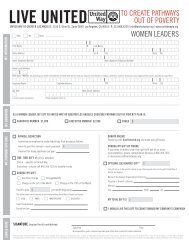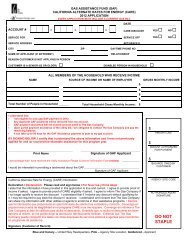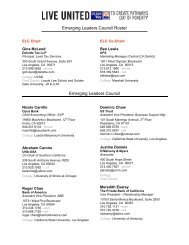- Page 1 and 2: American Dream Makers Latino Profil
- Page 3 and 4: AMERICAN DREAM MAKERS LATINO PROFIL
- Page 5 and 6: CONTENTS Introduction Latino Profil
- Page 7 and 8: INTRODUCTION PURPOSE The study was
- Page 9 and 10: Latino Profiles Committee David Hay
- Page 11 and 12: AMERICAN DREAM MAKERS ACTION AGENDA
- Page 13 and 14: Goals Fuel the “Economic Engine
- Page 15 and 16: Latino Profiles Action Agenda Confe
- Page 17 and 18: STATISTICAL DATA on Latinos in Los
- Page 19 and 20: ELDERLY 1.38 Elderly Population by
- Page 21 and 22: EDUCATION - Continued 4.05 Spanish
- Page 23 and 24: Los Angeles County Interagency Coun
- Page 25: DEMOGRAPHIC PROFILE: Key Findings T
- Page 29 and 30: CHILDREN AND YOUTH Latino Children
- Page 31 and 32: Pediatric HIV/AIDS Transmission •
- Page 33 and 34: •= The Southern California Immigr
- Page 35 and 36: Table 1.01 RACE/ETHNIC GROUPS Los A
- Page 37 and 38: TABLE 1.02 RACE/ETHNIC POPULATION E
- Page 39 and 40: TABLE 1.02 RACE/ETHNIC POPULATION E
- Page 41 and 42: TABLE 1.02 RACE/ETHNIC POPULATION E
- Page 43 and 44: TABLE 1.02 RACE/ETHNIC POPULATION E
- Page 45 and 46: TABLE 1.02 RACE/ETHNIC POPULATION E
- Page 47 and 48: LATINO POPULATION - 1998 Los Angele
- Page 49 and 50: Table 1.05 LATINO POPULATION PROFIL
- Page 51 and 52: Population Growth Table 1.07 CENTRA
- Page 53 and 54: Population Growth Table 1.09 COLOMB
- Page 55 and 56: Table 1.11 CUBAN POPULATION PROFILE
- Page 57 and 58: Population Growth Table 1.13 ECUADO
- Page 59 and 60: Population Growth Table 1.15 HONDUR
- Page 61 and 62: Population Growth Table 1.17 NICARG
- Page 63 and 64: Population Growth Table 1.19 PERUVI
- Page 65 and 66: Table 1.21 SALVADORAN POPULATION PR
- Page 67 and 68: Population Growth Table 1.23 VENEZU
- Page 69 and 70: Table 1.25 AGE STRUCTURE AND MEDIAN
- Page 71 and 72: ETHNIC CHILDREN'S SCORE CARD 1999 -
- Page 73 and 74: Table 1.28 CHILDREN LIVING WITH PAR
- Page 75 and 76: Table 1.30 YOUTH AGE 16-19, WORKING
- Page 77 and 78:
Table 1.32 CHILDREN'S SERVICES CASE
- Page 79 and 80:
Table 1.34 CHILD ABUSE DEATHS CHARA
- Page 81 and 82:
Table 1.36 ACCIDENTAL CHILD DEATHS
- Page 83 and 84:
Table 1.38 ELDERLY POPULATION BY RA
- Page 85 and 86:
Table 1.40 EDUCATIONAL ATTAINMENT -
- Page 87 and 88:
Table 1.42 LABOR FORCE PARTICIPATIO
- Page 89 and 90:
Table 1.44 FOREIGN-BORN PERSONS BY
- Page 91 and 92:
Table 1.46 CITIZENSHIP STATUS, ALL
- Page 93 and 94:
Table 1.48 IMMIGRATION AND NATURALI
- Page 95 and 96:
Table 1.50 LATINO LANGUAGE USE Los
- Page 97 and 98:
Table 1.51 LANGUAGE SPOKEN AT HOME
- Page 99 and 100:
Table 1.51 LANGUAGE SPOKEN AT HOME
- Page 101 and 102:
Table 1.51 LANGUAGE SPOKEN AT HOME
- Page 103 and 104:
Table 1.51 LANGUAGE SPOKEN AT HOME
- Page 105 and 106:
BUILDING STRONG COMMUNITIES: Key Fi
- Page 107 and 108:
high rate of intermarriage with oth
- Page 109 and 110:
•= •= •= •= •= •= •=
- Page 111 and 112:
Latino Physician Shortage •= The
- Page 113 and 114:
Table 2.01 PUBLIC OPINION POLL DATA
- Page 115 and 116:
Table 2.03 BIRTH CHARACTERISTICS BY
- Page 117 and 118:
Table 2.04 BIRTH CHARACTERISTICS BY
- Page 119 and 120:
Table 2.04 BIRTH CHARACTERISTICS BY
- Page 121 and 122:
Table 2.04 BIRTH CHARACTERISTICS BY
- Page 123 and 124:
Table 2.04 BIRTH CHARACTERISTICS BY
- Page 125 and 126:
Table 2.04 BIRTH CHARACTERISTICS BY
- Page 127 and 128:
Table 2.06 YEARS OF POTENTIAL LIFE
- Page 129 and 130:
Table 2.08 MOTOR VEHICLE CRASH DEAT
- Page 131 and 132:
Table 2.10 PHYSICIAN TO POPULATION
- Page 133 and 134:
Table 2.11 CHILD NUTRITION INDICATO
- Page 135 and 136:
Table 2.13 PERSONS WITH NO HEALTH C
- Page 137 and 138:
Table 2.15 CASES OF SELECTED* NOTIF
- Page 139 and 140:
Table 2.17 AIDS CASES REPORTED BY R
- Page 141 and 142:
Table 2.19 ARRESTS BY RACE/ETHNIC G
- Page 143 and 144:
Table 2.19 ARRESTS BY RACE/ETHNIC G
- Page 145 and 146:
Table 2.21 FAMILY/HOUSEHOLD TYPE BY
- Page 147 and 148:
FUELING THE ECONOMIC ENGINE: Key Fi
- Page 149 and 150:
•= •= •= •= •= •= •=
- Page 151 and 152:
increasingly recognized by business
- Page 153 and 154:
Housing and Home Ownership •= 65.
- Page 155 and 156:
Table 3.02 MINORITY AND WOMEN-OWNED
- Page 157 and 158:
Table 3.04 LATINO FIRMS BY INDUSTRY
- Page 159 and 160:
Table 3.06 EMPLOYMENT AND LABOR FOR
- Page 161 and 162:
Table 3.08 OCCUPATIONAL CATEGORIES
- Page 163 and 164:
Table 3.10 WORKERS IN FAMILY BY RAC
- Page 165 and 166:
Table 3.12 POVERTY RATE BY RACE/ETH
- Page 167 and 168:
Table 3.13 LATINOS BELOW POVERTY LE
- Page 169 and 170:
Table 3.13 LATINOS BELOW POVERTY LE
- Page 171 and 172:
Table 3.13 LATINOS BELOW POVERTY LE
- Page 173 and 174:
Table 3.15 POVERTY BY RACE/ETHNIC G
- Page 175 and 176:
Table 3.17 PUBLIC ASSISTANCE RECIPI
- Page 177 and 178:
Table 3.19 FAMILY INCOME BY ETHNIC
- Page 179 and 180:
Table 3.21 HOUSEHOLD INCOME BY RACE
- Page 181 and 182:
Table 3.23 RATIO OF FAMILY INCOME T
- Page 183 and 184:
Table 3.25 FHA LOANS BY RACE/ETHNIC
- Page 185 and 186:
Table 3.27 HOUSING QUALITY INDICATO
- Page 187 and 188:
LIFE-LONG LEARNING
- Page 189 and 190:
•= Spanish is the home language o
- Page 191 and 192:
COMPUTER USE •= Since there is no
- Page 193 and 194:
LATINO INTERNET RESOURCES This shor
- Page 195 and 196:
Fiera (Spanish Language Internet Se
- Page 197 and 198:
Chicano Studies National Latino Res
- Page 199 and 200:
Table 4.01 TEACHERS BY RACE/ETHNIC
- Page 201 and 202:
Table 4.03 PRIVATE AND PUBLIC SCHOO
- Page 203 and 204:
Table 4.05 SPANISH SPEAKING STUDENT
- Page 205 and 206:
Table 4.07 HIGH SCHOOL GRADUATES WI
- Page 207 and 208:
Table 4.09 COLLEGE AND UNIVERSITY E
- Page 209 and 210:
Table 4.11 EDUCATIONAL ATTAINMENT O
- Page 211 and 212:
Table 4.13 HATE CRIME VICTIMS: PERP
- Page 213 and 214:
Table 4.15 RELIGIOUS HATE CRIME Los
- Page 215 and 216:
Table 4.17 CHILDREN'S COMPUTER USE
- Page 217 and 218:
BIBLIOGRAPHY on Latinos in Los Ange
- Page 219 and 220:
Arts, Culture and Identity 1 Campoa
- Page 221 and 222:
35 Villaseñor, V. Rain of Gold. Ho
- Page 223 and 224:
35 (1998): 627-634. 14 NALEO Educat
- Page 225 and 226:
Capitalism.” Economic Development
- Page 227 and 228:
18 Greene, J. P. Bilingual Educatio
- Page 229 and 230:
Elderly 1 Aleman, S. Hispanic Elder
- Page 231 and 232:
22 Waldinger, R. Beyond the Sidestr
- Page 233 and 234:
(1995): 127-135. 24 Cervantes, A. I
- Page 235 and 236:
56 Hayes-Bautista, D., Barriers to
- Page 237 and 238:
Cancer - Screening Test Among Latin
- Page 239 and 240:
Epidemiology 141 (1995): 428-439. 1
- Page 241 and 242:
27 Portes, A. Immigrant America: A
- Page 243 and 244:
5 Camarillo, A. Chicanos in a Chang
- Page 245 and 246:
40 The Tomás Rivera Policy Institu
- Page 247 and 248:
Council of La Raza, 1997. 27 The Na
- Page 249 and 250:
UNITED WAY LATINO PROFILE PROJECT F
- Page 251 and 252:
y focus group participants in many
- Page 253 and 254:
that, yeah, we do contribute social
- Page 255 and 256:
developed in greater depth below, i
- Page 257 and 258:
-You see commercials now that you w
- Page 259 and 260:
over the years, more and more Latin
- Page 261 and 262:
these communities, the African Amer
- Page 263 and 264:
America or South America.’ There
- Page 265 and 266:
organice y llegue a tomar algun dia
- Page 267 and 268:
Low Self Esteem, Low Self Confidenc
- Page 269 and 270:
dominant, second and third generati
- Page 271 and 272:
-[Immigrant Latinos] well, they’r
- Page 273 and 274:
-We brought the family philosophy t
- Page 275 and 276:
SURVEY METHODOLOGY The survey was a
- Page 277 and 278:
Emerging Influence More Latinos tha
- Page 279 and 280:
Bright Futures Strong agreement was
- Page 281 and 282:
Glass Ceiling Non-Latino groups are
- Page 283 and 284:
Comfort With Diversity - Cont. Ther
- Page 285 and 286:
Multilingual Los Angeles Angelenos
- Page 287 and 288:
Academic Success - Cont. 100% Many
- Page 289 and 290:
STUDY ID#: 2133 SUMMER, 1999 LOS AN
- Page 291 and 292:
4. Using the same rating scale, I w
- Page 293 and 294:
Next we have some questions about y
- Page 295 and 296:
12. The following statements are ab
- Page 297 and 298:
20. In what religion were you raise
- Page 299 and 300:
These last questions are for descri
- Page 301 and 302:
39. Was your approximate total hous
- Page 303 and 304:
LOS ANGELES COMMUNITY SURVEY #2133
- Page 305 and 306:
9. I need to find out just a little





